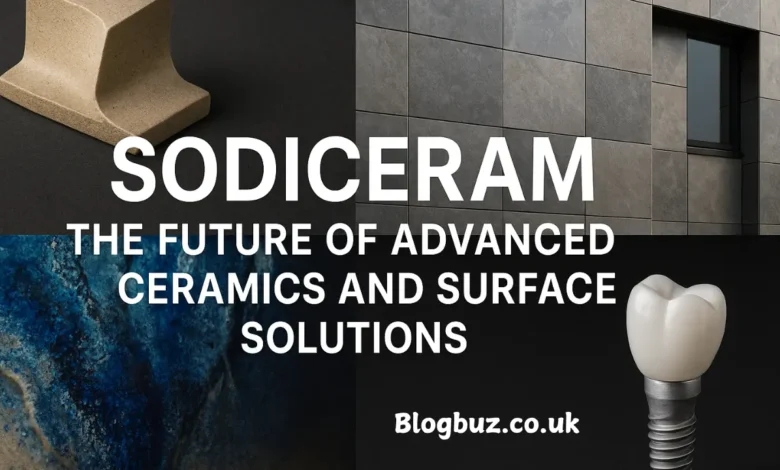Sodiceram: The Future of Advanced Ceramics and Surface Solutions

In the evolving world of materials science and design, Sodiceram has emerged as a standout innovation—combining traditional ceramic artistry with cutting-edge technology. From its applications in modern architecture and industry to its appeal in artistic and DIY communities, Sodiceram is redefining what ceramics can do. This article explores what Sodiceram is, its properties, use cases, benefits, and why it’s increasingly shaping the future of ceramics.
What Is Sodiceram?
Sodiceram refers to a category of high-performance, sodium-enhanced ceramic materials. These ceramics are engineered using advanced formulations that often include sodium oxide, alumina, silica, and zirconia. This unique chemical combination yields ceramics that exhibit remarkable thermal resistance, durability, chemical inertness, and versatile design capabilities.
While the term has industrial and scientific relevance, it also holds significance in craft pottery, where “Sodiceram” techniques involve sodium-based glazing or vapor processes to create stunning, organic surface effects. Thus, Sodiceram lives at the intersection of engineering and art.
The Science Behind Sodiceram
The key to Sodiceram’s success lies in its sodium-infused matrix. Sodium compounds interact with other ceramic components to:
- Enhance thermal resistance, making the material suitable for high-temperature applications.
- Improve mechanical strength, allowing it to withstand pressure, impact, and abrasion.
- Enhance chemical resistance, ideal for industries such as healthcare, energy, and aerospace.
This is achieved using specialized manufacturing processes such as:
- Sintering at high temperatures
- Spark Plasma Sintering (SPS)
- Additive manufacturing (3D printing of ceramics)
- Surface glazing using sodium salts or soda firing
As a result, Sodiceram products can be custom-designed for both technical and decorative needs.
Sodiceram in Modern Architecture
One of the most transformative uses of Sodiceram is in building and design. Its ability to maintain integrity under UV exposure, moisture, and heat makes it a preferred material for:
- Facade cladding panels
- Floor and wall tiles
- Countertops and backsplashes
- Outdoor installations
These surfaces offer a unique combination of aesthetic appeal and functional durability. Architects and interior designers value Sodiceram for its natural stone-like finish, its customizable textures, and its eco-conscious properties.
Moreover, the ability to digitally print high-resolution images onto Sodiceram tiles offers endless design potential for both commercial and residential projects.
Sodiceram in Industrial and Technological Applications
Beyond architecture, Sodiceram plays a vital role in industries that require extreme performance under stress and high temperatures. Key sectors include:
Aerospace & Defense
- Used in heat shields, turbine blades, and engine linings.
- High melting point and strength make it ideal for aircraft and spacecraft applications.
Automotive Engineering
- Applied in brake pads, engine components, and thermal insulators.
- Lightweight and heat-resistant, improving both performance and fuel efficiency.
Energy & Electronics
- Used in solid-state batteries, fuel cells, and insulators.
- Conductivity features allow for advanced energy storage solutions.
These use cases showcase the adaptability of Sodiceram across high-value, high-tech environments, contributing to innovation in material engineering.
Sodiceram in Healthcare and Biomedicine
The biocompatible nature of Sodiceram has also opened doors in the medical field. Applications include:
- Dental prosthetics
- Bone implants and joint replacements
- Surgical tools and devices
Thanks to its non-reactive, antibacterial properties and strength, Sodiceram is increasingly seen as a material of choice in long-lasting medical solutions.
Sodiceram and Ceramic Arts
In the world of studio pottery and ceramics, “Sodiceram” also refers to a technique or aesthetic approach—often involving soda firing. Here’s how it works:
- Sodium carbonate or bicarbonate is introduced into a high-temperature kiln.
- These sodium vapors react with silica in the clay body.
- The result is a glossy, textured glaze with flowing, unpredictable surface patterns.
Artists appreciate Sodiceram for the uniqueness it brings to each piece—no two are ever identical. This makes it highly desirable in artisanal markets, galleries, and bespoke interior décor.
Environmental and Sustainability Benefits of Sodiceram
Sodiceram’s sustainability credentials make it a favorable choice for eco-conscious developers and manufacturers:
- A long lifespan means fewer replacements and reduced waste.
- Recyclable—ceramic waste from manufacturing can be reprocessed.
- Low-emission kilns and energy-efficient sintering techniques minimize carbon footprints.
- Many producers engage in ethical sourcing, community development, and educational initiatives related to ceramics.
With the global shift toward green architecture and materials, Sodiceram stands out as an environmentally responsible solution.
Challenges and Limitations of Sodiceram
Despite its many advantages, there are challenges to consider:
- High production costs result from the use of specialized techniques and materials.
- Scaling issues, especially for defect-free, large-format components.
- Market resistance exists as industries and consumers continue to transition from traditional ceramics to plastics.
- Knowledge gap—both consumers and some manufacturers may not fully understand the value or maintenance needs of Sodiceram.
Nevertheless, as technology continues to develop and demand increases, these hurdles are expected to lessen over time.
Comparing Sodiceram to Traditional Ceramics
| Feature | Sodiceram | Traditional Ceramics |
|---|---|---|
| Heat Resistance | Up to 1600°C+ | ~1000°C |
| Mechanical Strength | Very high | Moderate |
| Surface Durability | Excellent | Average |
| Aesthetic Variety | High (custom printing, glazes) | Moderate |
| Eco-Friendliness | High (recyclable, low emissions) | Varies |
| Cost | Higher | Lower |
This comparison clearly shows why Sodiceram is considered premium, performance-driven, and future-ready.
Conclusion: Why Sodiceram Matters
In summary, Sodiceram represents a technological leap in the world of ceramics—balancing strength, style, and sustainability. Whether it adorns the exterior of a luxury building, enhances the performance of a rocket engine, or adds character to a handcrafted vase, Sodiceram proves that innovation and tradition can coexist.
Its relevance across multiple domains—architecture, aerospace, healthcare, energy, and art—highlights its versatility. As industries and consumers alike demand stronger, greener, and more aesthetically pleasing materials, Sodiceram is poised to be at the forefront of this transformation.
You May Also Read: Wolf Containers Carisle Pa: Your Trusted Partner for Packaging Solutions




